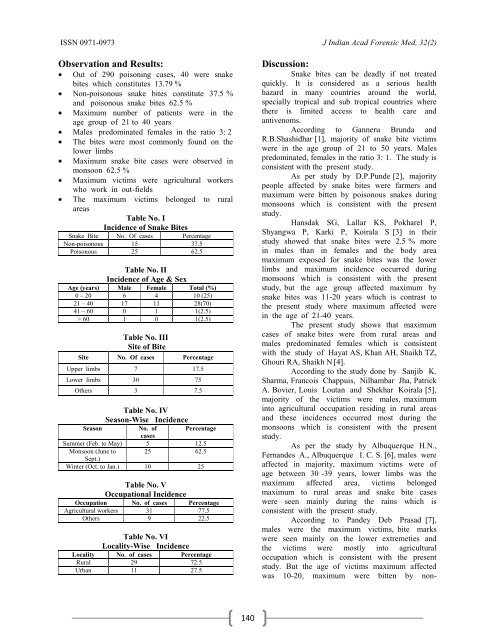jiafm, 2010-32(2) april-june. - forensic medicine
jiafm, 2010-32(2) april-june. - forensic medicine
jiafm, 2010-32(2) april-june. - forensic medicine
- No tags were found...
Create successful ePaper yourself
Turn your PDF publications into a flip-book with our unique Google optimized e-Paper software.
ISSN 0971-0973 J Indian Acad Forensic Med, <strong>32</strong>(2)Observation and Results:Out of 290 poisoning cases, 40 were snakebites which constitutes 13.79 %Non-poisonous snake bites constitute 37.5 %and poisonous snake bites 62.5 %Maximum number of patients were in theage group of 21 to 40 yearsMales predominated females in the ratio 3: 2The bites were most commonly found on thelower limbsMaximum snake bite cases were observed inmonsoon 62.5 %Maximum victims were agricultural workerswho work in out-fieldsThe maximum victims belonged to ruralareasTable No. IIncidence of Snake BitesSnake Bite No. Of cases PercentageNon-poisonous 15 37.5Poisonous 25 62.5Table No. IIIncidence of Age & SexAge (years) Male Female Total (%)0 – 20 6 4 10 (25)21 – 40 17 11 28(70)41 – 60 0 1 1(2.5)> 60 1 0 1(2.5)Table No. IIISite of BiteSite No. Of cases PercentageUpper limbs 7 17.5Lower limbs 30 75Others 3 7.5Table No. IVSeason-Wise IncidenceSeasonNo. of PercentagecasesSummer (Feb. to May) 5 12.5Monsoon (June to 25 62.5Sept.)Winter (Oct. to Jan.) 10 25Table No. VOccupational IncidenceOccupation No. of cases PercentageAgricultural workers 31 77.5Others 9 22.5Table No. VILocality-Wise IncidenceLocality No. of cases PercentageRural 29 72.5Urban 11 27.5Discussion:Snake bites can be deadly if not treatedquickly. It is considered as a serious healthhazard in many countries around the world,specially tropical and sub tropical countries wherethere is limited access to health care andantivenoms.According to Ganneru Brunda andR.B.Shashidhar [1], majority of snake bite victimswere in the age group of 21 to 50 years. Malespredominated, females in the ratio 3: 1. The study isconsistent with the present study.As per study by D.P.Punde [2], majoritypeople affected by snake bites were farmers andmaximum were bitten by poisonous snakes duringmonsoons which is consistent with the presentstudy.Hansdak SG, Lallar KS, Pokharel P,Shyangwa P, Karki P, Koirala S [3] in theirstudy showed that snake bites were 2.5 % morein males than in females and the body areamaximum exposed for snake bites was the lowerlimbs and maximum incidence occurred duringmonsoons which is consistent with the presentstudy, but the age group affected maximum bysnake bites was 11-20 years which is contrast tothe present study where maximum affected werein the age of 21-40 years.The present study shows that maximumcases of snake bites were from rural areas andmales predominated females which is consistentwith the study of Hayat AS, Khan AH, Shaikh TZ,Ghouri RA, Shaikh N [4].According to the study done by Sanjib K.Sharma, Francois Chappuis, Nilhambar Jha, PatrickA. Bovier, Louis Loutan and Shekhar Koirala [5],majority of the victims were males, maximuminto agricultural occupation residing in rural areasand these incidences occurred most during themonsoons which is consistent with the presentstudy.As per the study by Albuquerque H.N.,Fernandes A., Albuquerque I. C. S. [6], males wereaffected in majority, maximum victims were ofage between 30 -39 years, lower limbs was themaximum affected area, victims belongedmaximum to rural areas and snake bite caseswere seen mainly during the rains which isconsistent with the present study.According to Pandey Deb Prasad [7],males were the maximum victims, bite markswere seen mainly on the lower extremeties andthe victims were mostly into agriculturaloccupation which is consistent with the presentstudy. But the age of victims maximum affectedwas 10-20, maximum were bitten by non-140



![syllabus in forensic medicine for m.b.b.s. students in india [pdf]](https://img.yumpu.com/48405011/1/190x245/syllabus-in-forensic-medicine-for-mbbs-students-in-india-pdf.jpg?quality=85)



![SPOTTING IN FORENSIC MEDICINE [pdf]](https://img.yumpu.com/45856557/1/190x245/spotting-in-forensic-medicine-pdf.jpg?quality=85)

![JAFM-33-2, April-June, 2011 [PDF] - forensic medicine](https://img.yumpu.com/43461356/1/190x245/jafm-33-2-april-june-2011-pdf-forensic-medicine.jpg?quality=85)



![JIAFM-33-4, October-December, 2011 [PDF] - forensic medicine](https://img.yumpu.com/31013278/1/190x245/jiafm-33-4-october-december-2011-pdf-forensic-medicine.jpg?quality=85)


